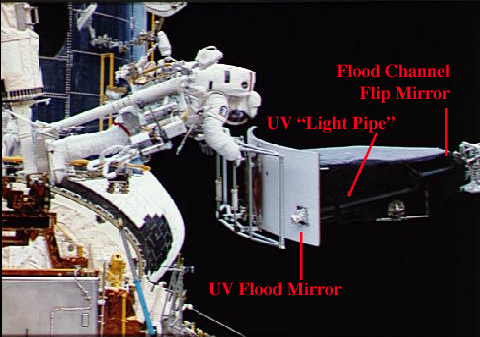 Astronaut Jeffrey Hoffman on foot restraint attached to the robot arm of the Space Shuttle's Remote Manipulator System (RMS) after removing WF/PC from HST during Servicing Mission 1. |
Almost forgotten in the annals of the early days of the Hubble Space Telescope mission (i.e., in the "bad old days" when "Spherical Aberration" was the buzz-word for the popular press) is the fact that the Wide Field Planetary Camera (WF/PC) obtained an EUV (Extreme Ultraviolet) image of the Sun.
What? You cry? HST can't point at the Sun!
True, it can't. But, as they say, "it's all
done
with mirrors".
 Astronaut Jeffrey Hoffman on foot restraint attached to the robot arm of the Space Shuttle's Remote Manipulator System (RMS) after removing WF/PC from HST during Servicing Mission 1. |
The Texas Instruments front-side illuminated CCDs, flown in the original WF/PC, suffered from Quantum Efficiency Hysteresis (QEH, which was remedied with the MPP clocked back-side illuminated Loral CCDs flown in the replacement WF/PC 2). The deleterious photometric effects of QEH can be mitigated by subjecting the CCDs to a strong dose of short wavelength UV photons, a process commonly referred to as a "UV Flood". UV photons of this sort come "free" in Earth orbit - from the Sun. WF/PC 1 was designed to take advantage of that. Sunlight could be directed onto the WF/PC 1 detectors by means of a small "backward pointing" telescope system, like a periscope sticking out of the side of the instrument's external thermal radiator. Sunlight then reflects off of a small, protectively covered external flat mirror (the UV Flood Mirror) and into the UV Light Pipe. At the interior end of the Light Pipe a "Flip Mirror" is moved direct the sunlight into WF/PC while blocking the optical path from the instrument's "pick off mirror" which receives light from the HST Optical Telescope Assembly (OTA). Thus, WF/PC 1 had a "choice" of two telescopes, HST's 2.4 meter diameter Cassegrain system, or its own little periscopic refractor.
During the original Orbital Verification (OV) phase of the HST mission, a special engineering test (proposal number 1478; J. Westphal, PI) had been designed and carried out to validate the WF/PC 1 UV Flooding process. As part of this test we needed to map out exactly where the backward pointing "flood aperture" was on the sky as seen through the WF/PC optical system. So, in October of 1990, we pointed HST at the ANTISUN, a fictitious moving target 1 Astronomical Unit from the Earth and diametrically opposed to the Sun in the sky. The spacecraft executed a 16-point "step and dwell" raster scan, while WF/PC 's CCDs imaged pieces of the Sun's photosphere through its UV Flood Channel. Exposure times of 0.11s were used and images were obtained through WF/PC 1's F122M and F230W filters used in combination (central wavelength of the pass band = 1220 Angstroms). Actually, this was done twice, with the telescope at slightly different "roll angles" with respect to Celestial North. The resulting images allowed us to accurately ascertain the metrology of the UV flood aperture with respect to the HST OTA focal plane, and (b) measure the depth of the flooding process (photoelectron deposition) which was achieved.
Many of the individual CCD images contained significant scattered light artifacts (after all, solar imaging is not what WF/PC was designed to do). And, several points in the rasters "missed" the Sun completely. Picking and choosing the most defect and artifact free sub-array regions from amongst the images, the jig-saw puzzle was assembled, and HST significantly pre-dated SOHO and TRACE in obtaining an EUV image of the solar disk. Well, it may not be of the fidelity of those which can be obtained by those spacecraft which are designed for this task, but it is an interesting, but often forgotten, part of the history of the HST mission.
Oh? The assembled (though uncalibrated)
image?
Here it is:
* At the time we executed the UV Flood Guiding
Verification
Test, and obtained these solar images with HST, I was working at the
Space
Telescope Science Institute as an Operations Astronomer for WF/PC-1 (an
instrument which has a few other, interesting little tricks up its
sleeve).
Some of the original WF/PC-1 hardware, returned to Earth by the STS-61
crew, will find its way again into the aft shroud of HST with the
installation
of WFC-3 in Serving Mission #4. But, we have seen the first, and
last, images of the Sun ever to be taken with HST.